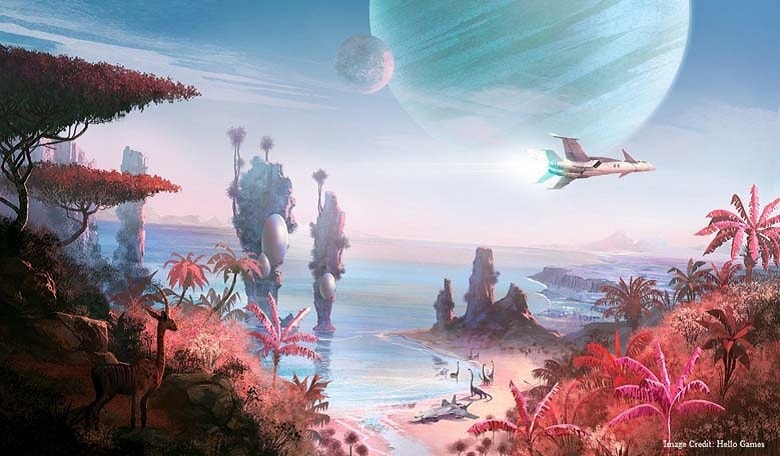When it comes to much-hyped video games, the space community rarely notices, even if those games themselves are set in space. But when it comes to “No Man’s Sky,” there is much, potentially, to be excited about.
Developed by UK-based Hello Games, “No Man’s Sky” (release date TBA) is one of the most hotly anticipated games of 2015. No one quite seems to know what it is about in its entirety – in the sense that we don’t know the plot, or if there is a plot, even.
What we know is that players get to explore a never-ending (more on that in a minute) universe – flying spaceships, landing on planets, gathering materials, shooting at stuff– but whether or not the game has an overarching narrative remains to be seen.
The original 2013 trailer for the game instantly became a hit:
The fact that the game promised to be “infinite” was an immediate attention-grabber.
The visuals of the game, exquisitely crafted, blending vintage representations of the cosmos with lush, modern design technique, made it memorable.
A new gameplay trailer is equally mesmerising:
Although there are no advance reviews yet, Yahoo’s Ben Silverman played “No Man’s Sky” for ten minutes at the E3 convention in Los Angeles and brought back the verdict of “awesome.”
Yet while there are many “awesome” games set in space, the space community itself rarely embraces them. “No Man’s Sky” could be different.
The reason for that is the secret algorithm that allowed the game-makers to create 18 quintillion – yes, 18 quintillion, you read that right – planets in the game.
Obviously, this imagination-defying number means that the planets were not made from scratch by the game’s small design team.
The algorithm has generated a lot of talk in the gaming industry. The space community, meanwhile, needs to look at the bigger (pun intended) picture.
The sheer size of our own solar system is something that is very hard for the human mind to contemplate, let alone fully grasp. And that is just our solar system we are talking about.
Even popular size comparison videos and memes aren’t entirely able to bring home the information on the vastness of space, because they require passive viewing, as opposed to active participation.
(Not that they aren’t talented in their own right, as you can see below)
“No Man’s Sky” could be the first game to genuinely address, and, over the course of time, mould, human perception of space and the actual distances contained therein.
If you’re a science teacher trying to explain space to middle-schoolers, getting them to play a game like “No Man’s Sky” for a week could constitute an immersive experience into the topic.
More importantly, if the game is successful, and becomes one of those titles that winds up being played for years by its fans, it could become a useful tool in any number of studies of human perception of vastness and distance.
Naysayers will point out that the lush worlds of “No Man’s Sky” have nothing to do with actual deep space exploration, which, with the technology we have today (and will probably have tomorrow and the day after tomorrow – though where technological progress on the issue of space travel will ultimately lead the human race is an open question), would mostly amount to a lot of sitting around in a cramped ship.
Yet the purpose of “No Man’s Sky” obviously has nothing to do with utilisation of today’s technology. Instead, the game’s premise – or what we know of it so far – appears to be more like an exciting thought exercise, a look at what “we shall not cease from exploration” truly means in the space age.











